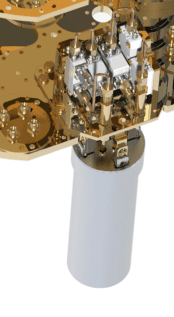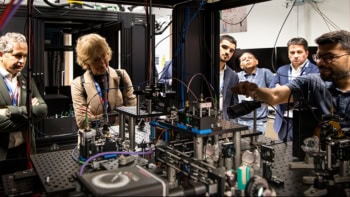Quantum Business Europe aims to accelerate the next technological revolution by helping industry discover the wide-ranging potential of quantum innovations

Science and innovation are essential ingredients for a technological revolution, but they are not enough alone. Other driving factors are the need for businesses to adopt new technology to encourage interactions between the developers and the potential end users to discover applications.
Promoting this type of communication is a key goal of Quantum Business Europe (QBE), a conference that brings together researchers and industry leaders to spark collaborations and accelerate the quantum revolution in Europe.
After a successful initial event last year, QBE is returning for a second edition from 23-24 March 2022. It will be held in a fully virtual format, with sessions livestreamed and made available to attendees for two months after the conference.
With the rapid developments happening in the quantum sector, the QBE organizers believe that the question for businesses is no longer whether they should implement quantum technology, but rather how they can best use it to advance their goals.
QBE therefore aims to help companies get ahead of the curve by equipping them with the knowledge and connections to assess how quantum can meet their needs and to build their own “roadmap” for deploying it.
To this end, the programme features more than 50 speakers including experts from tech giants and start-ups in all three primary areas of quantum 2.0 technology: computing, communications and sensing.
Among the speakers are also representatives of industrial associations and government bodies, with the opening session to be given by Tommaso Calarco, chair of the European Quantum Community Network. He will discuss the EU’s current standing in quantum technologies and how it is capitalizing on its advantages in the field.
Other keynote sessions include one by John Martinis of the University of California, Santa Barbara, delving into what quantum computers actually are – and why they are not simply the next generation of supercomputers – and another by Gabriel Puebla-Hellmann, CEO of QZabre, looking at how quantum sensing is already having real-world impacts.
There will be two streams of talks and roundtables in the afternoons. Topics will range from end user applications of quantum computing, such as materials discovery and drug design, to the skills required for the European quantum industry and best practices in quantum software development.
In addition, there will be more than 30 technology-demonstration sessions showcasing the latest advances in the European quantum sector. Zurich Instruments will demonstrate its new qubit controller for superconducting quantum processors, while Atom Computing will discuss recent results in scalability and error correction for neutral-atom qubits.
Cryogenics company Bluefors will present the latest developments in its dilution refrigerator measurement system, which are outlined below, and the applications for quantum measurements.
To participate in Quantum Business Europe, you can register for a full conference pass or for free access to the virtual exhibition and demo sessions on the event’s website.
Cryogenic technology supports quantum measurement

Finnish firm Bluefors is a leader in the area of dilution refrigerators, which can be used to cool quantum computers based on superconducting qubits. The company has recently announced multiple developments to support and enable the evolving measurement needs of the quantum industry.
Late last year, Bluefors introduced KIDE, its largest cooling system yet, which is designed to facilitate the large-scale experiments involved in the near-to-medium-term goals of the quantum-computing community. Furthermore, the KIDE units are structured so they can be clustered together to form an even bigger system if required.
Another new solution that Bluefors will be launching in the near future is an integrated readout module comprising everything needed to perform qubit readout. This module combines several advances developed by the company in recent years. For example, it includes Bluefors’ coaxial infrared filter, which absorbs and dissipates relatively high-energy photons coming from thermalized components, protecting quantum devices from radiative heating and decoherence while preserving high signal fidelity.
Another key feature of the integrated readout module is the travelling wave parametric amplifier (TWPA), which is designed to amplify signals near the quantum limit. Set to be showcased at the Quantum Business Europe conference, it has a wide gain bandwidth of 4-8 GHz, with a high gain of 15dB across 80% of this range, with only a minimal amount of added noise, around 300mK.
The high performance of the TWPA has been demonstrated with a cryogenic variable temperature noise source – a diagnostics tool also developed by Bluefors. This tool can be used to add a controlled and well-defined amount of noise into an amplifier cascade, allowing analysis of the amount of intrinsic noise introduced by the amplifier. This is crucial for correcting and optimizing qubit readout.
- For more information about Bluefors’ recent developments and their applications to quantum measurement, you can tune into the company’s demo session on 23 March at Quantum Business Europe.




